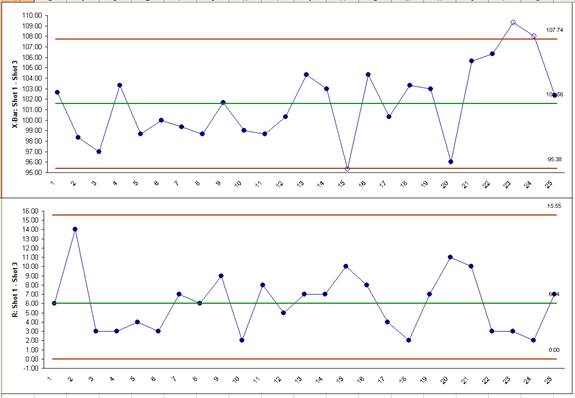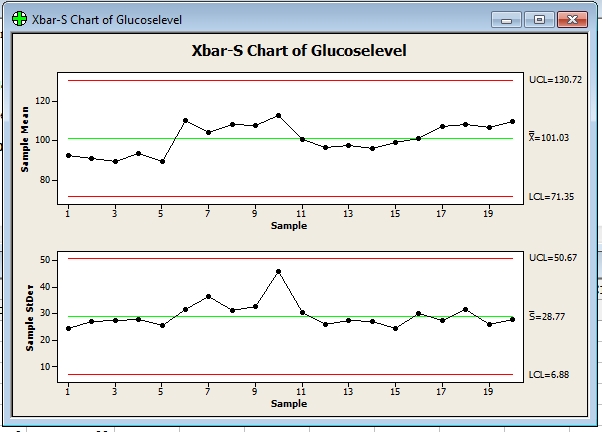

This is another sign of a poor measurement system.Types of Control Charts (SPC).There are various types of control charts which are broadly similar and have been developed to suit particular characteristics of the quality attribute being analyzed. Interactions would mean that certain parts were measured differently (with either more or less variation) by certain operators. You are looking for parallel lines, which means there are no interactions. The last chart (bottom right) shows the interaction plots for operator by parts. If there is one operator with an average higher or lower than the others, then it confirms that they have an influence on the final measurement, and therefore the measurement system is inadequate. A good measurement system would not allow operators to cause a difference in the readings, so you are looking for a straight line, which means that across all parts, the operators averaged close to the same readings. The next chart (middle right) shows the differences between operators using their overall average reading. If the individual points are spread out from each other on each sample, then it means the measurement system is having a hard time picking up whether the variation is coming from the part or the measurement system itself. This means that the parts are quite different from one another, while the measurement is taking readings very close to the part average. In an ideal chart, the variation in the parts should be large, in comparison to the variation in the readings around the average for each part. The next chart (top right) shows the individual readings of each part. If the chart shows data points within control, then your measurement system is making it difficult to measure part to part differences. This means that the part variation is easy to detect, despite the variation in the measurement system. If you have a good measurement system, then this chart should be out of control (all points outside the control limits). The X-bar chart (bottom left) shows the part variation, using the measurement system R chart from above, for the limits.

If it is out of control (points outside control limits), then there is no consistency to the measurement system. If your R chart is in control (almost all data points inside the control limits), then that is a good sign. The next chart, the R chart (middle left), shows the repeatability and reproducibility variation This will be evident on the other charts as well, so make sure your conclusions match all the charts. In the bad example, most of the variation is coming from Reproducibility (Operator), rather than Repeatability. If the system is unacceptable, look at the 'Repeat' and 'Reprod' groups, to see where the majority of the variation is coming from. UNACCEPTABLE - Must improve measurement process so % of Tolerance is less than 10%, or less than 30% with Ppk greater than 1.67 MARGINAL – If Ppk is less than 1.67, then improve measurement process until % of Tolerance is less than 10%, otherwise, no action is required Here is the criteria for determining if your measurement system is adequate, using the different % calculations in Minitab (taken from AIAG guidelines for the gage R&R table The good chart below that shows a very small blue bar, which means the measurement system takes up very little variation, compared to the spec limits of the item being measured. In the examples above, the far left group of charts shows a blue bar above the 50% mark. If the % is less than 10%, then I have an adequate measurement system. I would then look at whether the repeatability or reproducibility % was greater, in order to determine what I need to improve. If that number is greater than 30%, then I have a problem with my system. Others use '% of StudyVar' (green) or '% of Contribution' (orange) This provides me with a quick assessment of the measurement system. The first place I look is the R&R variation as a % of Tolerance (blue). There are three comparisons made from these results: % of overall variation (StudyVar), % of Tolerance (Spec Limit width, if entered into report), and % of Contribution. The first chart (upper left corner) is your breakdown of variation, into Part, Repeatability, and Reproducibility. In this article, we will look at two different examples, one for measuring TAB WIDTH (poor results), and the other measuring CAP BOW (good results)
#XBAR R CHART MINITAB HOW TO#
However, there is some confusion and a lack of knowledge on how to interpret each chart, in order to better understand the validity of your measurement system. Minitab provides a great Gage R&R six-pack chart, when performing a Gage study.


 0 kommentar(er)
0 kommentar(er)
